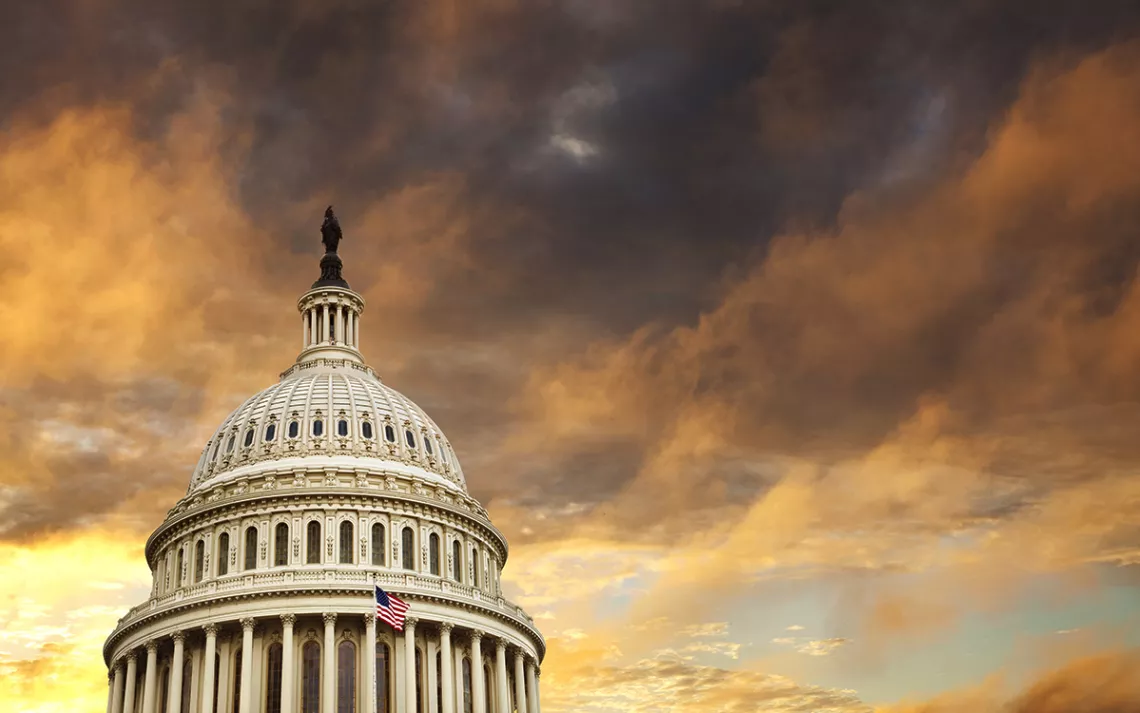As the Infrastructure Bill Moves Forward, Is a Climate Bill Next?
Progressives call for climate action

Photo by Willard/iStock
The last time Democrats tried to pass a big climate bill, they had better odds than they do now.
They still failed.
It was the summer of 2009. Democrats had just been handed a filibuster-proof majority in the Senate, and combating climate change was one of their top priorities. That May, then-representatives Henry Waxman and Ed Markey introduced the American Clean Energy and Security Act. Its centerpiece was a convoluted cap-and-trade model that Democrats hoped would attract Republicans but ended up dividing climate activists. It scraped by in the House with a vote of 219–212. In the Senate, the bill was never even put up for debate.
In the decade since, both the climate crisis and the possibility that Congress will respond to it have only gotten worse. In the 50–50 Senate, Democrats have the slimmest possible margin for error. They are, once again, staring down mid-term elections that could cost them their fragile majorities in both chambers of Congress. Meanwhile, climate change is knocking at the door. Much of the West is experiencing “extreme” drought, flash floods are threatening the Great Plains, and, on the Atlantic Coast, Americans are bracing for yet another more active than usual hurricane season. No part of the country has been spared from an oppressive heat wave. Both politically and ecologically, the stakes couldn’t be higher.
Last week, just a day after the National Weather Service forecasted that the historic and dangerous “heat dome” would torch Seattle—where two-thirds of homes lack air conditioning—President Joe Biden walked out of the White House, flanked by senators from both parties, and announced that they had agreed on an infrastructure bill. The framework, which proposes spending $1.2 trillion over eight years, includes $109 billion for roads and bridges, $66 billion for Amtrak to expand service and make needed repairs, and $73 billion to upgrade the nation’s electrical grid. It would also allocate $47 billion to help make coastal infrastructure climate-resilient, $21 billion to clean up toxic waste, and $7.5 billion to install a network of electric-vehicle charging stations.
Yet the framework is a far cry from the ambitious climate bill Biden proposed in his so-called American Jobs Plan.
“This bipartisan bill is not a climate bill. We need to begin the shift to 100 percent clean energy and put our nation on the path to maintain warming at 1.5 degrees Celsius,” said Emily Samsel, the national press secretary for the League of Conservation Voters, referring to the threshold scientists have established for staving off the worst effects of climate change. “The infrastructure bill, alone, would not do that.”
At least a dozen senators have said they will not vote for the bipartisan bill unless it is accompanied by a companion bill dedicated to combating climate change, which Democrats in the Senate could pass along party lines through the procedural maneuver known as budget reconciliation. The hashtag #NoClimateNoDeal is trending on Twitter.
“I cannot support a deal that does not have climate at its center,” now-senator Markey, Democrat of Massachusetts, told MSNBC last week. “No climate, no deal.”
“Let me be clear: There will not be a bipartisan infrastructure deal without a reconciliation bill that substantially improves the lives of working families and combats the existential threat of climate change,” Senator Bernie Sanders, independent of Vermont, tweeted on Sunday. “No reconciliation bill, no deal.”
Despite its absence in the bipartisan framework, climate legislation like what Democrats are proposing has wide bipartisan support among voters nationally. A recent survey of more than 1,200 likely voters conducted by the environmental group Climate Power and the think tank Data for Progress found that 57 percent of Americans support Biden’s American Jobs Plan. When surveyors provided more details about the proposal—including its investments in clean energy and funding to clean up abandoned oil wells and mines—that support increased to 65 percent, with the largest increase among Republicans.
Given this support, there’s a fear among Democrats that failure to pass such provisions would spell disaster for the party’s chances in 2022. “Last fall, Americans in every corner of this country voted for climate action. Right now, they are holding these IOUs,” Markey said. “The GOP—or, the gas and oil party—would love nothing better than for these voters to be disillusioned by gridlock and inaction.”
Much of the environmental community is in agreement on the provisions that need to be included in the reconciliation bill. Melinda Pierce, the legislative director of the Sierra Club, said that the bill should be built around a federal clean energy standard that would mandate the decarbonization of the electricity sector by 2035. This would be coupled with a 10-year, $300 billion package of clean energy tax credits to support the expansion of renewable energy sources like wind, solar, and battery storage. Samsel, the League of Conservation Voters press secretary, added that at least 40 percent of new investments must go to frontline communities and communities of color.
“The science is clear that we have about a decade to act. And it is going to take at least a decade to put these measures in place,” said Pierce. “We have to pass legislation today. This is a once-in-a-generation chance. The stars are aligned, but we’re running out of time.”
Democrats are determined to move forward with both the bipartisan infrastructure bill and a climate bill. Last week, Senator Chuck Schumer, Democrat of New York and the majority leader, said that he would pursue a two-track strategy in July. “These two efforts are tied together,” Schumer said in remarks on the Senate floor. “If the Senate is going to move forward with the bipartisan infrastructure bill, we must also move forward on a budget resolution as well.”
And in the House, Speaker Nancy Pelosi has promised that she will not send the bipartisan bill to Biden for signature until the Senate proves it can pass the reconciliation bill. “There ain’t going to be an infrastructure bill unless we have a reconciliation bill passed by the United States Senate,” she told reporters at her weekly news conference.
Just hours after Biden threw his weight behind the infrastructure framework, he delivered what appeared to be an ultimatum: He would not sign the bipartisan deal without Congress passing a much more expansive climate bill. “If this is the only thing that comes to me, I’m not signing it,” Biden told reporters. “I’m not just signing the bipartisan bill and forgetting the rest of it.”
Almost immediately, Republicans who had backed the bipartisan framework called foul. “No deal by extortion!” tweeted Senator Lindsey Graham, Republican of South Carolina. “It was never suggested to me during these negotiations that President Biden was holding hostage the bipartisan infrastructure proposal unless a liberal reconciliation package was also passed.”
After Biden and White House aides spent the weekend rolling back the president’s comment, the bill seems to be back on track. But the turbulence points to just how difficult the two-track process will be.
The only way Biden can hope to pass a climate bill is through the budget reconciliation process. And the only way to get the 50 votes he needs to make that happen is to honor the desire among centrist Democrats, such as Senator Joe Manchin of West Virginia and Senator Kyrsten Sinema of Arizona, to pass a bipartisan infrastructure bill. For now, at least, that strategy seems to be working. “We’ve worked on one track. We’re going to work on the second track,” Manchin said on ABC. “There’s an awful lot of need.”
But whether Biden can get enough Republicans to support the bill remains to be seen. His legacy—and the fate of the climate—stands on the edge of a knife. Will he be known as a dealmaker, or as the president who let our last best chance to pass climate legislation slip away?
 The Magazine of The Sierra Club
The Magazine of The Sierra Club



